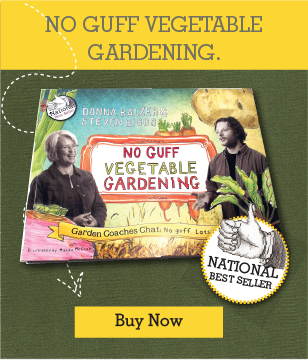
I help gardeners grow
& beginners blossom.
No seed left behind,
no soil unturned.
Together we can have lots of fun growing
great gardens using simple practical tips.
- Featured in -





Start saving & storing your garden seeds for a more more sustainable future
SIGN UP to get the FREE Seed packet PDF
X CLOSE

Ants in Your Plants- A Solution?
Do you keep ant killer in your kitchen?
“Well it turns out every year I seem to have this crazy problem with ants. Seems that no matter what I do there are ants, ants, ants”, said Heather in a voicemail. “Now I don’t see them at first when I go to plant my beloved strawberry or watermelon plants – but as soon as they are in the ground all of a sudden the ants show up, the stalks are nibbled on and they fall over, dead.”
Just before Heather left me this phone message I was told by a CBC listener on my regular phone-in show in Alberta that Splenda (the artificial sweetener) was an ant killer. Yes, the very same Spenda, an artificial sweetener, many people consume daily and store in their kitchen cupboards was being reported as an ant killer.
I was sure Splenda would not work. I had naively tried all the other crazy things CBC listeners have pawned off on me over the years. Yes it is true. I am the plant expert and people phone me with their bug problems or worse yet their solutions to other caller’s bug problems. I repeat: I am a horticulturist, not an entomologist.
Rightly or wrongly I always march right home and try these (usually bug) solutions myself. I was told (by a listener) that large rhubarb leaves spread over an anthill would kill ants. NOT TRUE.

I placed rhubarb leaves over my ant hill to deter ants. It did not work.
I was told (by a listener) ants would explode from eating a sprinkling of dry Cream of Wheat (not cooked) on their anthill. NOT TRUE. (I assume it’s the same for other breakfast cereals and even though I have seen recent reports online that other cereals work – I suspect there is no substance to this cereal theory.)
And so when I was told Splenda kills ants I was a little hesitant to endorse or deny this claim. So I turned to the formidable Dr. Ken Fry (Ph.D. Entomologist) at Olds College for advice and he was helpful but not hopeful: “Further work needs to be done to evaluate high doses of aspartame.”
A research paper he sent me focused on fire ants: The mortality rates of workers fed erythritol, aspartame, and saccharin were higher than 80% and were significantly higher than for those fed D-glucose anhydrous and water. That sounds good except we don’t have fire ants in Alberta or BC or anywhere in Canada as far as I know.
Jouni Sorvari, University of Eastern Finland focused his study on black ants, and thinks the whole sweetener thing is an urban legend: Our results strongly oppose the rumors that aspartame sweeteners are effective as an ant poison, at least with a typical dose of household aspartame products.
So of course I went out and bought Splenda for my own ant problems. I also suggested it to Heather in response to her question about ants in her plants because she was “at my wits end and tired of spending money on plants that just weren’t going to make it.”

Splenda is the brand of sweetener suggested by a CBC listener to kill ants. I gave it a try.
I don’t have trouble with ants in my garden but I bought and sprinkled Splenda in the cracks where my south facing concrete pad meets my house and the conditions rival high noon in the Mohave Desert in August. I noticed right away that Splenda does not contain Aspartame or any of the other products referred to in the studies Ken had forwarded. Instead the active ingredient in Splenda is Maltodextrin (corn) and Sucralose. I’m no chemist but this is a different product from what the official studies report investigating, so I was hopeful.

I noticed two things right away. My puppy was attracted to the Splenda and, once I locked her up inside and spread more, the two types of ants I had observed traipsing through and living under my house disappeared overnight. As a bonus there were a few pillbug carcasses on the concrete pad. Maybe they usually die here and the ants cart them away or maybe Splenda kills pillbugs too.
Meanwhile Heather said she “went and “borrowed” some [Splenda] from my local coffee shop, in the little packets, and brought them home and sprinkled them all around the flower box and actually in the soil. (I’m not sure if you are supposed to do that.)
And also [I spread] a little bit on the plants, but not very much! And I have to say I have not seen any ants. Maybe one or two few sniffing around (probably to see that this is not a good idea.) But that is about it. So I am optimistic that maybe there is a solution. And it is called Splenda! I wonder if they’ll put that in their commercials coming up soon!
I took a few videos of the busy ants before the Splenda application but there is not much to see now on my hot concrete pad with the ants gone. Maybe they are breeding a bigger and better and more resistant version of themselves and will pop up again next summer. Or maybe I am fooling myself and the dog ate all the ants along with the Splenda and she will die soon.
As I said I am no scientist and I am not certain that Splenda works for ant control in every situation. It’s been two weeks since the first call from Heather and she is cautiously optimistic and has not lost any plants yet. I was skeptical and now I am convinced there is something going on with Splenda and I am certain I will never ever eat or cook with it or serve it to company. I am not sure what Maltodextrin or Sucralose are something is killing the ants. Bring on the sugar!
What Would Donna Do?
Get my growing and gardening tips and pointers throughout the season.
















I have tired many ant control products, and it seems only Diatomaceous Earth works for me. It is food grade and appear to be very safe for human, so I was applying around my garden, and it works perfectly.
Make sure read the level before purchasing it..
Hi Angie – Could you send a photo to my email ([email protected]) of the insects and the damage? The white insects sound just like whiteflies – very common and easy to deal with but they don’t eat plants – they suck sap. Looking forward to hearing from you.
Hi Donna
I have been having problems with an insect that looks like a little white fly in my gardens – from the flower beds to the raised vegetable garden. It doesn’t matter what I plant. Everything gets infected with these little white fly-like insects that puff up in a swarm when disturbed. I am not sure how to get rid of them or why I have them. There is sap all over the leaves like my mint and flowers, but leafy greens like beets, kale, and lettuce have holes and are consumed down to the stems. What are these insects and what can I do to get rid of them? Any guidance you can provide would be greatly appreciated!!
Update for Al and Patty – I found the empty bottle of bugs I bought to fight fungus gnats. It is from Applied Bionomics in Sydney BC and it is a great idea if you have a big greenhouse or big garden and lots of trouble. I used it once several years ago and I am still clear of fungus gnats. The predatory bug is a mite and is called Stratiolaelaps scimitus (used to be called Hypoaspis miles.) In fact if there are any worm bin people out there this would work for you as well!
Bonus – and coming from a pro like Al I would say good advice all around. In bad news the fungus gnats often come with the soil so expect them.
It does sound like Fungus Gnats. We get them too and have found that Sticky Strips seems to get them as they are attracted to yellow.
Hi Patty- It sounds like you have fungus gnats. Your soil is too wet so they are breeding in it. Try letting the soil dry a bit more between watering! Also there are bugs that kill these bugs. Maybe a good topic for a future article!?
Hi Donna,
This isn’t about ants, but it is about bugs. I’ve noticed recently that when I water my flower pots a bunch of flying bugs get disturbed. You can’t see them until they all lift off. If they land nearby, they look almost like a dried piece of grass until you look closer and see that they are an insect. Any idea what they are and if they are harmful? I’ve never had this kind of issue before.
An update from my usual source Dr. Ken Fry just arrived. “Given that Splenda does contain sucralose (sucrose with chlorine substituted for 3 hydrogen-oxygen groups) it may be that the chlorine is the killing agent. I can find no research that shows how the chlorine might be toxic in its given form, bound to the sucrose. I would suspect that toxicity would be apparent to humans and render the product void for human consumption. Therefore I am sceptical about its effects on ants.”
Good to know. Thanks for sharing. Can you believe we eat these things too? Scary.
I have had success with Purity brand cornmeal as well Donna, so I agree it is the corn.
Yes I have read the same reports about Round-up. It is everywhere for sure… not good for us and definitely not good for the ants.
That is so interesting April & Al! Who knew so much could be wrapped up in one simple “fake” sweetener
I have read that all corn grown in North America is genetically modified, or GMO, except for a few farmers that have held onto their own heirloom seed for generations. Recently, a lot of claims have been made that many ‘foods’ we eat contain massive doses of the herbicide Roundup that exceeds safe consumer limits. Perhaps it is the herbicide that gets rid of ants?
What I found most interesting is that Maltodextrin = corn. My lawn was over run with ants until I started using cornmeal gluten on it about 5 years ago. The cornmeal gluten did nothing to prevent weeds but the ants disappeared quickly. I’ve had no problem with ants ever since. I wonder if there is something about corn.
You are so right Al! Heather is a new gardener and after speaking with her further it was a case of her plants drying out because the ant populations were so high. The splenda seemed to cut the ant numbers down and she has not lost a plant since she tried it two weeks ago. And – for anyone else reading, you are not a novice. You are obviously a well-studied and knowledgeable gardener who spots very fine distinctions! Thanks for your input!
I may be a novice here but ants don’t nibble on plants like strawberry or watermelon in my experience. Slugs and pill bugs will eat the actual fruit of a strawberry but not those woody stems. Caterpillars might but rabbits certainly would eat those stems. Slugs and cutworms will cut all my cucurbits in half so we have to grow them in 4″pots and set them out as larger plants so that one chomp doesn’t do as much damage as to a tiny plant. The only issue I see with ants is that they bring aphids to plums and cherries to farm them which causes leaf curl mutations and terminates any tip growth and hence bud formation for the following year. Ants are likely not the culprit here…
Hi Peggy! I hope you meant humorous! If it was humourless I am a failed writer! LOL.
Great! Let me know how it works for you.
Just read your article about ants and Splenda! I’m going to try it on my problem ant areas – I’m hopeful!!
A humourless read , ants and Splenda. ? Thanks Donna!